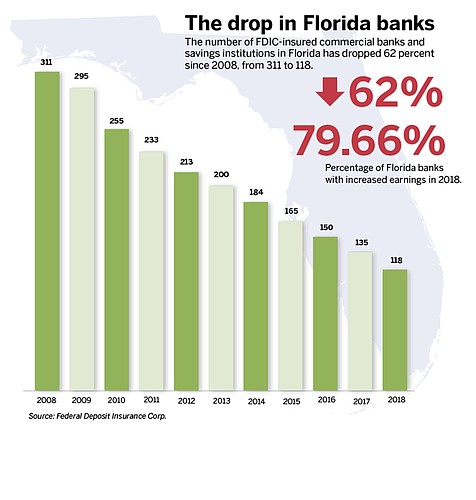
A decade after several major financial institutions collapsed in one of history’s worst banking crises, the industry appears to be in pretty good shape.
The Federal Deposit Insurance Corp. two weeks ago released third-quarter data for the industry showing aggregate earnings for all insured commercial banks and savings institutions were 29 percent higher than last year.
More than 70 percent of the 5,477 insured institutions nationwide increased earnings since last year’s third quarter and only 3.5 percent of them recorded a net loss.
The percentage of unprofitable banks and savings institutions in Florida was higher, at 8.47 percent, but 79.66 percent of Florida institutions increased earnings.
A comparison of Florida’s overall third-quarter performance with the state banking industry’s third-quarter 2008 performance shows just how far the industry has come in the past decade.
The percentage of unprofitable institutions in Florida was 54.02 percent in the third quarter of 2008 and the industry’s performance was even worse a year later, with 76.61 percent losing money in the third quarter of 2009.
Florida banks and savings institutions produced aggregate third-quarter earnings of $1.531 billion this year, compared with an aggregate loss of $1.074 billion 10 years ago and a loss of $1.699 billion in the third quarter of 2009.
The percentage of noncurrent loans to all loans was 2.66 percent for Florida institutions in this year’s third quarter.
Noncurrent loans are loans in which the borrower is at least 90 days overdue in payment or is not paying at all. The percentage of bad loans is a good indicator of the quality of a bank’s loan portfolio.
The ratio of noncurrent loans to total loans was 4.47 percent in the third quarter of 2008 and that jumped to 8.12 percent the next year.
Losses from bad loans sent numerous banks into failure during the crisis, and the FDIC data shows an upheaval in Florida’s financial industry over the past decade.
Florida had 118 FDIC-insured institutions at the end of the 2018 third quarter, down from 311 in the third quarter of 2008.
The number of employees at those institutions dropped from 31,590 a decade ago to 21,240 at the end of the third quarter.
Jacksonville was considered the banking capital of Florida for much of the 20th century but locally based banks have all but disappeared in the last decade.
FDIC data shows 20 banks headquartered in the Jacksonville metropolitan area at one time in the past decade.
But after a series of bank closures – and mergers of healthy banks into larger institutions – the Jacksonville area is down to two locally based institutions: Florida Capital Bank and TIAA.
TIAA was headquartered in St. Louis but merged with Jacksonville-based EverBank last year and moved the bank’s headquarters to EverBank’s offices.
One other institution, Ameris Bank, has its executive offices in Jacksonville but its official headquarters is in Moultrie, Georgia.
The number of banks has dropped nationally over the past 10 years, but not as drastically as the drop in numbers in Florida. The current total of 5,477 FDIC-insured institutions is down from 8,384 in 2008.
As the agency released the latest data, FDIC Chairman Jelena McWilliams highlighted the industry’s improvement since the last recession.
“It is worth noting that the current economic expansion is the second-longest on record, and the nation’s banks are stronger as a result,” she said, according to an FDIC transcript of the agency’s press briefing on the data.
However, McWilliams warned banks to remain vigilant against interest-rate and credit risk as they compete for customers.
“Attention to the prudent management of these risks will position banks to be resilient so that they can sustain lending through the economic cycle,” she said.